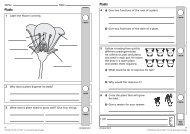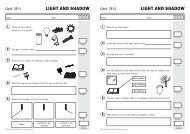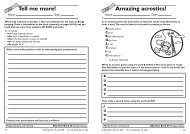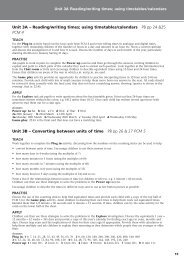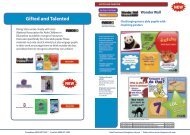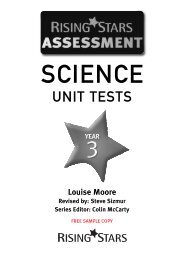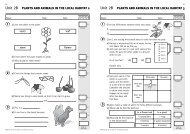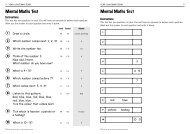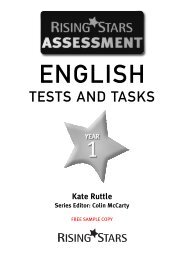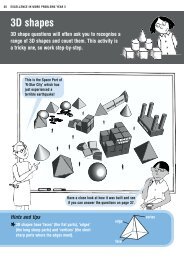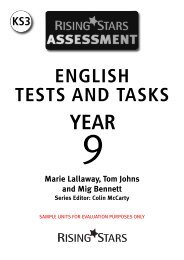FREE Reading Support pack - Rising Stars
FREE Reading Support pack - Rising Stars
FREE Reading Support pack - Rising Stars
You also want an ePaper? Increase the reach of your titles
YUMPU automatically turns print PDFs into web optimized ePapers that Google loves.
<strong>Reading</strong><br />
with<br />
<strong>Reading</strong><br />
<strong>Support</strong><br />
Pack<br />
Expert advice on<br />
supporting your<br />
struggling readers<br />
H Top 10 tips for<br />
successful reading<br />
intervention<br />
H How to tackle the<br />
gender gap in<br />
reading ability<br />
H The benefits of a<br />
well-stocked library<br />
H Improving storytelling<br />
in your school<br />
H eBooks and learning<br />
www.risingstars-uk.com/reading
<strong>Reading</strong> with<br />
<strong>Rising</strong> <strong>Stars</strong><br />
With Ofsted focusing more sharply<br />
than ever on raising attainment<br />
in reading, schools are<br />
searching for effective<br />
resources that can be<br />
used for intervention<br />
and support for their<br />
older struggling<br />
readers.<br />
<strong>Rising</strong> <strong>Stars</strong>’ range of<br />
reading resources:<br />
H Are specifically developed to<br />
engage older learners<br />
H Feature age-appropriate themes<br />
and storylines, but with a<br />
controlled language level that<br />
supports reluctant readers<br />
H Include extensive support material<br />
for teachers, TAs and LSAs with<br />
lots of advice and activities for<br />
guided reading sessions and reading<br />
intervention classes<br />
This reading support <strong>pack</strong> includes lots of<br />
useful help and advice from teachers and<br />
literacy experts showing how you can raise<br />
attainment in reading and create a reading for<br />
pleasure culture in your school.<br />
For more information on <strong>Rising</strong> <strong>Stars</strong>’ reading resources go to<br />
www.risingstars-uk.com/reading<br />
<strong>Support</strong>ing your<br />
Struggling Readers<br />
Paul Blum gives his top ten tips for successful reading intervention<br />
1 Accurate assessment<br />
Assesment before you start is really important. Make<br />
sure that you know your reader’s real reading level.<br />
Eight in ten words should be read accurately if the book<br />
is to work for your pupil.<br />
2 Praise and rewards<br />
Every five minutes try and say something positive about<br />
the progress your pupil is making. Use a reward<br />
stamp frequently, once every fifteen minutes<br />
minimum.<br />
3 Error free<br />
environment<br />
Make each step in your lesson so<br />
simple that it’s almost impossible<br />
for your pupil to trip up and get<br />
it wrong.<br />
4 Over learning<br />
Go over the same material<br />
again and again so that you<br />
really reinforce the lesson<br />
objectives.<br />
5 Light touch<br />
phonics<br />
Many weak readers are<br />
turned off by phonics.<br />
They have had a lot of over<br />
exposure to it in the early<br />
years of primary. So when<br />
you use phonic teaching<br />
methods, do it sparingly and<br />
for short periods of time. Five<br />
minutes is long enough.<br />
Paul Blum has worked in London schools for<br />
more than 25 years as both a senior manager and<br />
SENCO. He has worked extensively with groups of<br />
struggling readers and is the author of Shadows,<br />
The Matt Merton Mysteries, Vampires Inc. and<br />
The Extraordinary Files.<br />
6 Real reading opportunities<br />
A good storyline with exciting characterisation and<br />
conflict is essential for your readers. They need to be<br />
truly engaged.<br />
7 Fun and entertainment<br />
Try and make your lessons varied and exciting. Praise<br />
and rewards are key to this, but so is the use of a bit of<br />
drama and role play.<br />
8 Mixed bag of interventions<br />
Variety is key. Pupils like a routine but they like a<br />
routine that keeps them guessing and has a variety of<br />
teaching strategies. No single strategy will appeal to<br />
everybody in your group.<br />
9 Involve parents<br />
Parents often feel frustrated about the reading skills of<br />
their son or daughter. Try and get them to reinforce the<br />
reading process at home and participate in the praise<br />
and rewards system you are using at school.<br />
10 Short, simple personal<br />
targets<br />
Each pupil needs to know what they are aiming for.<br />
Explicit short term targets for each reading session are<br />
very helpful, especially when reinforced with rewards<br />
and praise. This makes target setting entertaining.
Here Come the Boys<br />
Bill Boyd looks at the<br />
widening gender<br />
gap in reading<br />
The Boys’ <strong>Reading</strong> Commission findings<br />
published in July 12 reveal that three out<br />
of four (76%) UK schools are concerned<br />
about boys’ underachievement in reading,<br />
despite no Government strategy to<br />
address the issue. Last year an estimated<br />
60,000 boys failed to reach the expected<br />
level in reading at age 11.<br />
The all-party Parliamentary Literacy Group<br />
Commission’s report compiled by the<br />
National Literacy Trust reveals that the<br />
‘reading gender gap’ is widening and says<br />
action needs to be taken in homes, schools<br />
and communities, with recommendations<br />
including boys having weekly access to<br />
male reading role models.<br />
The problem with politicians and survey<br />
findings of course is that:<br />
a) they always want action but have no<br />
idea what it should be<br />
b) they want a quick fix when it almost<br />
never exists and<br />
c) they usually believe the solution lies in<br />
introducing a new test, or the revision<br />
of an old test, or a compulsory ‘reading<br />
hour’ or some such, all of which are<br />
only likely to compound the problem.<br />
My own experiences over a long number<br />
of years as a reader, a father and an<br />
English teacher lead me to believe that<br />
the problem is not so clear-cut as the<br />
figures suggest, but nonetheless there<br />
are some measures which can sensibly<br />
be taken to encourage reading, especially<br />
among boys.<br />
Finding Positive Role<br />
Models<br />
One of the more constructive suggestions<br />
of the Commission’s report is that boys<br />
need strong male role models. There is<br />
no escaping the facts that most teachers,<br />
especially in the primary sector, are<br />
women and many boys have no positive<br />
male role models in their lives. Schools<br />
should go out of their way to find strong<br />
male readers in the community, whether<br />
they are parents, local sportsmen,<br />
community artists or whatever, and<br />
invite them to conduct reading sessions<br />
in school. I saw a suggestion on Twitter<br />
recently that men should consider<br />
volunteering to read to boys in their local<br />
school, but the initiative has to come<br />
from the school. Having created an ethos<br />
where adult males seeking involvement<br />
in their local school are often treated<br />
with suspicion, we need to take steps to<br />
redress the balance.<br />
The Teacher as<br />
Learner/Reader<br />
Teachers – male and female – must<br />
realise that first and foremost they<br />
themselves have to be a reader and a<br />
role model. Too often I meet teachers<br />
who have hardly picked up a book<br />
since they graduated from college or<br />
university. They should be immersed<br />
in books and reading, and it should be<br />
a frequent topic for discussion. This<br />
means that, apart from adult fiction and<br />
current literature relating to their own<br />
professional development, they should<br />
constantly be seeking out and reading<br />
books relating to the age group for which<br />
they have responsibility. This will often<br />
mean reading material which would not<br />
necessarily have been their own choice<br />
by instinct.<br />
Finding the Right<br />
Materials<br />
In my experience, when it comes to<br />
reading in schools, the emphasis is firmly<br />
on the reading of fiction. There needs to<br />
be much more of a balance. While fiction<br />
of course is important in so many ways,<br />
boys often favour non-fiction, and given<br />
a choice when visiting the library will<br />
overwhelmingly go for factual material,<br />
yet when it comes to the serious study of<br />
texts in the classroom, fiction wins out<br />
every time.<br />
We need to provide good quality nonfiction<br />
material, including biography,<br />
which will engage those who demand<br />
the facts! (the <strong>Rising</strong> <strong>Stars</strong> Download or<br />
Snapshots series are a particularly good<br />
example of attractive non-fiction texts for<br />
reluctant readers).<br />
Teachers should also consider seriously<br />
the place of comic books and graphic<br />
novels, both of which play an important<br />
part in in the development of boys’<br />
reading but are often ignored, or even<br />
more bizarrely dismissed, as an inferior<br />
form of storytelling. Speaking as an adult<br />
male reader, my own preference is to<br />
read fiction and non-fiction texts more or<br />
less alternately.<br />
Take a look at the Literacy Adviser Book<br />
Lists for 10-14 year olds at<br />
http://literacyadviser.wordpress.com/ for<br />
some suggested reads or find out more<br />
about <strong>Rising</strong> <strong>Stars</strong> range of books for<br />
reluctant readers at www.risingstars-uk.<br />
com/reading.<br />
Embracing New<br />
Technologies<br />
While many of us still prefer to pick up a<br />
paper book, especially when it is a picture<br />
book or one that has particular aesthetic<br />
appeal, new technologies have resulted in<br />
a revival of reading for many adults, and<br />
the advent of the eReader presents new<br />
opportunities for a new generation. Boys<br />
love gadgets, so why not take advantage<br />
of these new technologies to introduce<br />
them to texts which they might otherwise<br />
ignore. If you can’t afford a class set of<br />
Kindles or iPads, buy one or two and<br />
direct them specifically at those boys<br />
who don’t think reading is cool but think<br />
that machines are. The more gadgetry<br />
the better. Repeat after me – playing with<br />
gadgets and reading are not mutually<br />
exclusive.<br />
<strong>Rising</strong> <strong>Stars</strong>’ eBooks for schools can<br />
be read on PCs or netbooks as well as<br />
Kindles, iPads or iPod Touches. Find out<br />
more at www.risingstars-uk.com/ebooks.<br />
Timing is All<br />
The thing about reading is that there is<br />
a time and a place, and that time and<br />
place is different for every individual.<br />
I have followed some very interesting<br />
discussions recently on the blogosphere<br />
(see Kenny Pieper and David Didau in<br />
particular) on the place of silent reading<br />
in the classroom, the pros and cons,<br />
the optimal amount of time to spend<br />
and so on. This is a hugely complex<br />
issue depending on so many variables,<br />
including those already mentioned above.<br />
One thing of which I am fairly certain,<br />
and that is we are too often asking young<br />
people – especially boys – to read at the<br />
wrong time, a time which suits us rather<br />
than them. Silent reading is something<br />
which requires full attention and the right<br />
conditions, which are extremely difficult<br />
to replicate in a classroom. <strong>Reading</strong><br />
aloud, when done well and with the right<br />
texts, can motivate and engage even<br />
the most reluctant reader but moving<br />
them from there to reading willingly on<br />
their own is a different matter. Another<br />
factor which is often overlooked is that<br />
most boys need to be moving around and<br />
doing something physical before turning<br />
to more cerebral matters. I know that<br />
most of my reading is done after exercise,<br />
and not before it, when I find it more<br />
difficult to concentrate. Perhaps there is<br />
something to be learned here by anyone<br />
planning a learning programme.<br />
<strong>Reading</strong> Doesn’t<br />
Have to Involve<br />
Writing<br />
One of the surest ways to kill an interest<br />
in reading, especially among boys, is to<br />
insist that every time someone reads a<br />
book they have to write a review, or a<br />
‘critical evaluation’. To develop a genuine<br />
love of reading, young people need to be<br />
encouraged to TALK about books, read<br />
aloud and listen to extracts from the best<br />
writers, and make recommendations to<br />
each other. If you do want them writing<br />
about their reading, make it less formal<br />
and with a real purpose, such as a<br />
discussion forum in the form of a class<br />
blog or wiki.<br />
Bill Boyd is an independent educational<br />
consultant based in Scotland. He is a former English<br />
teacher, senior school manager and Education Manager<br />
at Learning and Teaching Scotland.<br />
Find out more about him and his work at<br />
http://literacyadviser.wordpress.com/<br />
The Library as the<br />
Beating Heart of the<br />
School<br />
The school library should be the learning<br />
hub from which all else emanates, the<br />
librarian a thorough professional and<br />
integral part of the learning team, not<br />
simply someone who issues books and<br />
collects fines. Too often, when budget<br />
cuts are being considered, it is the library<br />
which suffers first. In too many schools<br />
restrictive practices reinforce the notion<br />
that reading is something for a privileged<br />
elite, and boys are made less welcome<br />
because they are seen as boisterous and<br />
ill-disciplined. This can be witnessed<br />
most often when a teacher and/or<br />
librarian expects a prolonged period of<br />
silent reading without first cultivating<br />
the environment for this to happen. A<br />
more productive use of library time is to<br />
explore, discuss and work with individuals<br />
to find the right connections – the right<br />
book at the right time – a key role of the<br />
teacher/librarian.<br />
Finally, a word of advice. The world<br />
moves on, times change. Perhaps it’s<br />
time for people to revise and expand<br />
their definition of ‘reading’ to include all<br />
forms of reading, especially as it relates<br />
to moving image, transmedia and webbased<br />
texts. Who knows, when they do<br />
this they might discover that in fact there<br />
isn’t such a gender gap after all.
Love your library!<br />
Bev Humphrey looks at the importance<br />
of having a well-stock school library<br />
Your school library is the natural hub for<br />
encouraging reading for pleasure and should be<br />
at the heart of every school. The environment<br />
needs to look inviting and contemporary to<br />
tempt your students in and the benefits of<br />
having a dedicated professional staff member<br />
waiting to welcome students are clear. But of<br />
course if your book stocks are not exciting and<br />
up to date then you will not be able to retain<br />
the interest of those reluctant readers or to<br />
feed the appetites of voracious book lovers.<br />
In the past many children were taken to the public library<br />
regularly by their parents , and this still happens for some but<br />
sadly for lots of young people the first time they ‘meet’ a library<br />
is when they go to school. Happily there are so many fantastic<br />
series and standalone books published each year for the<br />
younger market no school library need rely on outdated dusty<br />
volumes – there is a book out there to capture every child’s<br />
imagination – you just have to find it, simple huh!<br />
The days of having no other distractions than a good book<br />
are over and youngsters have so many demands on their<br />
attention – texting, social media, gaming and television to<br />
name but a few and there are some boys and girls that will<br />
find thick books very off putting because they feel they<br />
will never finish them. Shorter novels can therefore be<br />
very popular and provide a way in to reading pleasure<br />
for pupils that don’t want to commit too much time<br />
to their reading. Hopefully feeding their appetite<br />
for ‘snack reading’ and then suggesting further<br />
reading in the same vein will encourage them<br />
to develop their attention span and take on<br />
longer books but if this takes a while it’s not a<br />
problem – after all I think we all enjoy a quick<br />
read now and then.<br />
Graphic novels or comics are always popular<br />
and there are so many fantastic ones<br />
published each year that it is easy to find<br />
books to feature prominently in your library.<br />
They range from classic stories retold in a<br />
way to engage today’s children to books that<br />
combine fact and fantasy, always a winner with<br />
boys (and girls) that usually stick to non-fiction<br />
titles. Girls that like pink books are catered for<br />
too, it’s not just boys that like graphic novels by any<br />
means. Encouraging students to create their own comics and<br />
then displaying them in the library for others to read creates<br />
interest – who knows maybe you have a graphic star of the<br />
future in your school!<br />
Please don’t neglect non-fiction, information books are<br />
perennially popular as can be seen from the constant demand<br />
for Guinness World Records and engrossing titles can be<br />
found for any particular topic or interest. Bug books, spiders<br />
especially (shudders) always go down well and titles on popular<br />
culture are a winner for some children. The non-fiction sections<br />
of some school libraries are jam <strong>pack</strong>ed with books on the<br />
topics that are studied in the national curriculum but if this is<br />
the total sum of your factual books you are missing out on a<br />
very powerful hook to get kids reading.<br />
It is so important to make sure that you have plenty of high<br />
interest low ability books available, if you are a 13 year old boy<br />
and you struggle with reading you don’t want to be seen taking<br />
out a classic reading scheme book and indeed you probably<br />
wouldn’t enjoy reading such a book. Look out for books that are<br />
targeted at this particular market. Series of books work<br />
well because children enjoy meeting the same characters in each successive book<br />
and like knowing the background story to them when they open a new title. It<br />
seems most genre preferences are catered for with high/low readers, humour,<br />
gritty realism, fantasy and those extremely popular vampire books so having<br />
a good selection is essential.<br />
For some young people the only play reading they do is when they<br />
have to do so when confronted with Shakespeare and this is a great<br />
shame. Struggling readers often greatly enjoy the group feel of<br />
reading a play with friends and they will pay attention much more<br />
when they are listening for their cues and enjoying hearing their<br />
peers read aloud. Make sure you have up to date plays at all<br />
ability levels in your library to facilitate this group reading,<br />
the format of a play can make it easier to digest when solo<br />
reading as well.<br />
So now you have your library stocked with shiny new inviting<br />
books how are you going to promote them to your students<br />
Tapping into their enthusiasm for technology works<br />
exceedingly well, even if it is only having a digital photo<br />
frame on the library desk with pictures of book covers from<br />
new acquisitions playing on a loop. If you are lucky enough<br />
to have a screen in the library showing book trailers, either<br />
found online or created by the boys and girls in your school<br />
can cause books to fly off the shelves, young people love<br />
moving images and showing book trailers can encourage them<br />
to break out of their self-imposed genre boundaries. Allowing<br />
your pupils to create a short film as a book review makes it much<br />
easier to get some peer recommendations going – even if a young<br />
person has loved a book it is often very difficult to get them to sit<br />
down and write a review. The ebook revolution is gathering pace and<br />
being able to provide reading materials in a digital form will become<br />
increasingly important, this is something that schools are going to have<br />
to explore very soon.<br />
With a library chock a block full of wonderful books and digital carrots to<br />
entice your pupils , reading for pleasure will become something that doesn’t<br />
have to be thought about … it will just happen.<br />
Bev Humphrey is a Literacy & Technology<br />
Consultant and founder of the Write Path International<br />
Collaborative Writing Project http://writepath.ning.com/.<br />
Find out more about Bev via her website<br />
www.bevhumphrey.com
I want to tell you a story<br />
Roger Hurn explains<br />
how to add impact to<br />
your storytelling<br />
There are lots of very good reasons why<br />
we should tell our children stories, but<br />
the main one is that everybody loves to<br />
listen to a great story, well told. A good<br />
storyteller can capture the listener’s<br />
imagination and hold them spellbound<br />
while he or she leads them into a world<br />
where anything can happen. So, it’s<br />
hardly surprising that storytelling is one<br />
of the world’s oldest and most accessible<br />
art forms, but the beauty of it is that it<br />
costs nothing and everyone can do it –<br />
and here’s how.<br />
Firstly, you must care about the story<br />
you’re planning to tell because, if you<br />
don’t then neither will your audience.<br />
The best stories to tell are the ones<br />
you loved to listen to when you were a<br />
child because that love will come across<br />
in the way you retell them. Moreover,<br />
folktales and fairy stories are good stories<br />
to choose because they are made for<br />
telling. They have clear action, strong<br />
characters and a simple structure with<br />
built-in memory aids like repetition. Of<br />
course, you need to pick a story that suits<br />
your listeners but<br />
remember<br />
most children of whatever age love a tale<br />
that has a really bad character in it. They<br />
all enjoy being scared by the villain just<br />
so long as good triumphs over evil in the<br />
end!<br />
And don’t worry about remembering<br />
every last detail of the story you’ve<br />
chosen to tell because you won’t. If you<br />
try you’ll either give up in despair; lose<br />
the flow of the story because you’re<br />
concentrating on the details and not the<br />
story itself or end up repeating the story<br />
in a mechanical, lifeless way. So, just<br />
identify the bare bones of the tale. You<br />
can do this by asking these questions:<br />
H What are the important things that<br />
happen in the story<br />
H Who does it happen to and why<br />
H What is the story really about<br />
H Whose story is it<br />
Then, when you’ve done this, make a list<br />
of the ten most important words in the<br />
tale. This will help you focus on what is<br />
really important and you can use these<br />
words as a skeleton on which you<br />
can put the flesh of the story.<br />
For example, in Jack<br />
and the Beanstalk<br />
the ten most<br />
important<br />
words<br />
might be:<br />
H Jack<br />
H Cow<br />
H Magic beans<br />
H Mother<br />
H Beanstalk<br />
H Giant<br />
H Golden goose<br />
H Harp<br />
H Chase<br />
H Axe<br />
When you’ve done this, try telling the<br />
story out loud to yourself. As long as your<br />
version of the story hangs together and<br />
makes sense don’t worry about any little<br />
details you’ve forgotten – they’re not<br />
important. The only details that matter<br />
are the ones that advance the story. And<br />
don’t waste time on poetic descriptions<br />
of people, places and things either. They<br />
just hold up the action and bore your<br />
listeners. A couple of well chosen words<br />
are all you need to convey the terror of<br />
the dark and shadowy wood where the<br />
red-eyed monster with ferocious fangs is<br />
waiting to pounce.<br />
Now we come to something really<br />
important – the opening lines of your<br />
tale. This isn’t the ‘Once upon a time’<br />
bit, it’s the actual start of the story – the<br />
springboard you’re using to plunge the<br />
listeners head first into the narrative.<br />
So make it count by using words that<br />
grab the listeners’ attention immediately<br />
and hook them. Here are a couple of<br />
examples of what I mean:<br />
Both these openings are guaranteed<br />
to have your listeners sitting forward<br />
desperate to hear what happens next.<br />
Then, once you’ve hooked your listeners,<br />
don’t forget to vary the sound and<br />
volume of your voice, the speed of your<br />
delivery and your facial expressions when<br />
you’re telling the main part of your tale.<br />
Moreover, don’t be afraid to make use<br />
of pauses and silences because variety<br />
catches and holds your audience’s<br />
interest. And use big gestures as this<br />
will help keep everyone’s eyes focused<br />
on you.<br />
You also need to pay special attention<br />
as to how you portray the characters in<br />
your story because vivid characters really<br />
bring a story to life. So, by using your<br />
face, voice, gestures and the<br />
way you move your<br />
body, you will<br />
make<br />
those characters live for your listeners.<br />
For example, stand up really tall and<br />
deepen your voice for a giant. But hunch<br />
up your shoulders, narrow your eyes and<br />
speak in a harsh voice for a wicked witch.<br />
Your audience will love it! But here’s a<br />
word of warning. Don’t try and put on<br />
too many voices as you’ll run the risk of<br />
getting them muddled up in the heat of<br />
the moment.<br />
And, talking of warnings, here are some<br />
other pitfalls to avoid when telling a story.<br />
Be very careful if you ask your listeners<br />
to join in when you’re in full flow as, like<br />
M with James Bond, you’ll be giving them<br />
a license to kill your story. And don’t ask<br />
your listeners questions either as you<br />
may not like or want the answers they<br />
give you.<br />
It is also wise to avoid<br />
using props or<br />
costumes<br />
as these<br />
have a<br />
nasty habit of breaking or falling off at<br />
just the wrong moment. Microphones<br />
and special effects are also best avoided.<br />
You’ll either deafen the audience with<br />
bursts of unwelcome feedback or<br />
disappear in a puff of smoke!<br />
So, to summarise, you must find the story<br />
you’re telling entertaining. If you don’t<br />
then nobody else will either. Your opening<br />
lines must hook your listeners’ attention<br />
immediately. Don’t tell a story with a cast<br />
of thousands, it’s too confusing. Chose<br />
a story with a beginning, middle and an<br />
end - preferably in that order as it’s a<br />
structure that has worked since stories<br />
were first told. Keep your story moving<br />
and don’t bore your listeners with too<br />
much description. Tell the story with<br />
plenty of expression in your voice and<br />
use your hands, eyes, facial expressions<br />
and body movement to bring the story<br />
alive. Oh yes, and make sure your story<br />
has a clear and satisfying ending. Your<br />
audience needs to know your story’s over<br />
without you telling them.<br />
And one last thing - make your<br />
storytelling sessions special. You can do<br />
this by simply turning off the lights and<br />
lighting a candle. This creates a magical<br />
atmosphere and the effect you achieve<br />
by blowing out the candle when you<br />
reach the end of your tale is truly<br />
satisfying.<br />
‘It was a wild, dark, stormy night and<br />
Jimmy woke up with a start. Something<br />
was coming out of his wardrobe…’<br />
‘The creepy old cottage looked deserted<br />
so, foolishly, Mary pushed the front door<br />
open …’<br />
Roger Hurn was a primary school head teacher<br />
and has taught at every level from nursery through to<br />
University. He is the author of the Mystery Mob series for<br />
reluctant readers and has had over 90 books published.<br />
Roger has travelled all over the UK and abroad sharing his<br />
stories with children and teachers.
The<br />
eBook<br />
revolution<br />
Jon Audain looks at how eBooks and<br />
iPads can engage students in reading<br />
Once upon a time in classroom far far away lived a book full of exciting<br />
stories, twists and turns, heroes and villains. Books have been used<br />
for many many years to support teaching and learning and for pure<br />
enjoyment. Just like the tale of Charles Dickens’ A Christmas Carol, the<br />
development of the technology, and specifically mobile technology such<br />
as iPads, have led to the written word developing it’s own past, future<br />
and present as the table reflects below.<br />
Past Present Future –<br />
The book +<br />
H Physical copy<br />
H Ability to share and<br />
huddle round a book.<br />
H Various shops and<br />
places to purchase and<br />
take out books.<br />
H Digital copy of a book<br />
H Portable<br />
H Text can be enlarged<br />
H Able to bookmark<br />
important pages<br />
H Able to make notes on<br />
the book<br />
H Able to record your own<br />
voice<br />
H Links to extra reading<br />
H Further activities<br />
H Videos<br />
H Pages can include<br />
animation<br />
H Sound clips<br />
H Widgets can be<br />
embedded into<br />
pages with the ability<br />
to display HTML,<br />
Presentations, videos,<br />
sounds, 3D pictures and<br />
quizzes<br />
eBook format<br />
eBooks can come in different formats<br />
from the industry standard of an ePub<br />
through to ePDFs and Apple’s own<br />
iBooks. Through the App store, iPad<br />
users can download books from the<br />
iBooks store but also download the Kindle<br />
apps widening the range of books which<br />
can be used.<br />
Using eBooks in the<br />
classroom<br />
Schools are now beginning to explore the<br />
potential of using eBooks. Here are some<br />
ideas for using them in the classroom:<br />
H Use the highlighters to identify the<br />
characteristics of characters or main<br />
events in a story.<br />
H Explore books such as The Pedal<br />
Lady or The Unwanted Guest from<br />
Moving Tales. The story is narrated but<br />
children also have the ability to record<br />
their own voice. This is a great tool<br />
for reinforcing reading aloud skills and<br />
reading with expression.<br />
H Younger children and beginner readers<br />
can enjoy the timeless classics of<br />
Ladybird reading books. These have<br />
been updated and children can hear<br />
the narration and then read it aloud<br />
for themselves. There are also sound<br />
effects embedded into the book.<br />
H There are some beautiful picture<br />
books such as Imagine a Night and<br />
Imagine a Day written by Sarah<br />
Thomson which can be used to<br />
stimulate creative writing. The<br />
accompanying illustrations are<br />
stunning. Connect your iPad up to your<br />
Interactive Whiteboard with a special<br />
adapter and it can be used with a<br />
starter lesson for creative writing.<br />
H Explore the future of books by look<br />
at the excellent The Fantastic Flying<br />
Book of Morris Lessmore. Based on a<br />
short film the book has been animated<br />
and further activities placed within the<br />
book from learning a tune on the piano<br />
through to visual effects within the<br />
pages.<br />
Using an iPad to<br />
support reading<br />
activities<br />
H If you have access to a mac computer<br />
then explore iBooks Author. A piece<br />
of software that enables the user to<br />
create their own eBook.<br />
H Explore other apps through the<br />
classroom. Word Cloud enables<br />
children to type in words to generate<br />
a visual word cloud in the same way<br />
as Wordle. Ask the children to think<br />
of their main character and to type<br />
words to describe that character. For<br />
Jon Audain is an Apple Distinguished Educator, a<br />
freelance trainer and a Senior Lecturer in Primary ICT and<br />
Music at the University of Winchester. His latest book<br />
‘The Grassroots Guide to Primary ICT’ will be published<br />
next spring 2013.<br />
example,<br />
use Roald<br />
Dahl’s Fantastic<br />
Mr. Fox to describe his<br />
character and his feelings towards the<br />
three farmers.<br />
H Ask the children in small groups to<br />
record the story with accompanying<br />
sound effects using a voice recorder<br />
app.<br />
H Explore the Book Creator app whereby<br />
children can create their own stories.<br />
These books can include photographs<br />
that have been taken with the iPad<br />
as well as text and sound clips. The<br />
finished book can then be published<br />
into iBooks for other children to enjoy<br />
reading.<br />
The future of the modern eBook on the<br />
iPad certainly looks exciting with many<br />
possibilities to push the boundaries of<br />
what books should look like in the future.<br />
Perhaps as well as the pictures being<br />
conjured in our head they may also come<br />
alive before our very eyes!
What works well –<br />
case studies from<br />
the classroom<br />
Marie Buckland from<br />
Oakhill First School<br />
in Redditch describes<br />
her experience of<br />
using eBooks in her<br />
classroom<br />
Using eBooks with my groups of reluctant<br />
Year 3 readers working at Level 1 has<br />
been a real revelation. I find that the use of<br />
technology motivates and engages reluctant<br />
and struggling readers. Using mobile devices<br />
enhances the quality of our sessions as the<br />
children are so enthusiastic that they quickly<br />
learn to use the technology in order to navigate<br />
the books with ease.<br />
I downloaded the Kids & Co. stories from<br />
www.i-<strong>Stars</strong>.co.uk for my guided reading<br />
sessions. They really engaged the children<br />
through familiar but humorous contexts, and<br />
within a term, both groups moved away from<br />
slowly decoding word-by-word in a monotone<br />
voice to reading enthusiastically with fluency,<br />
expression and understanding of the text.<br />
The illustrations were great for stimulating<br />
good discussion about the possible plot of<br />
the story and, enlarged on an a whiteboard,<br />
provided great opportunities to teach specific<br />
vocabulary related to the story by playing<br />
matching games, using the highlighting<br />
functionality and adding annotations.<br />
One of the key benefits of eBooks is being<br />
able to alter the size of the font on the screen<br />
and therefore not overwhelm the reluctant<br />
reader with toomuch text. I have also found<br />
that eBooks help to improve children’s reading<br />
fluency as key/high frequency words identified<br />
in a pupil’s IEP targets can be highlighted (either<br />
by them or me). This draws their attention to<br />
the words and reminds them of their targets.<br />
As well as leading to improved fluency,<br />
members of the group now read with<br />
more expression and greater variety in<br />
their intonation, demonstrating improved<br />
understanding of the meaning of what they<br />
have read. The audio recording facility on the<br />
mobile device was invaluable for helping the<br />
children achieve this, as the children were able<br />
to record, listen and evaluate how their own<br />
reading sounded.<br />
At the end of our sessions, the children are<br />
always very enthusiastic and want to share<br />
what we have done with the rest of their<br />
classes. I am now really looking forward<br />
to exploring how this renewed enthusiasm<br />
for reading can be transferred to writing by<br />
working with my groups to write their own<br />
eBooks for younger children based on high<br />
quality texts in familiar contexts.<br />
www.risingstars-uk.com/reading



